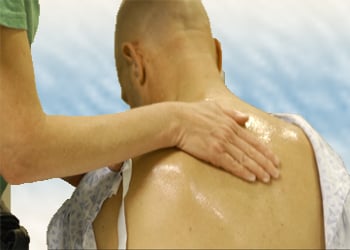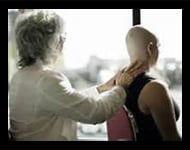
What is oncology massage?
Oncology massage is a form of bodywork. This type of massage was designed to meet the specific needs of cancer patients. It works with respect to medical treatments for the disease and aftereffects of cancer.
Oncology massage therapy enhances the healing process while respecting the body’s limits. Unlike chemotherapy and radiation, this massage therapy can be a welcome relief for patients because it is non-invasive.
Benefits
Oncology massage benefits the mind, body and spirit. This natural healing therapy relieves the mind and reduces stress, both mental and physical. It also soothes the soul and elevates spirits.
The relief provided gently encourages the body into a state of positive health and renewed strength. This combination enhances one’s sense of well-being and provides a sense of safety. In so doing, it lessens the depression that is commonly experienced by those diagnosed with cancer.
Alleviate side effects
Furthermore, oncology massage also provides many physical benefits. This type of massage can alleviate side effects that are experienced during the cancer treatment phases. Such side effects include those listed here.
- constipation
- diarrhea
- exhaustion
- general pain
- insomnia
- lack of appetite
- low blood counts (assists in building them up)
- nausea
Although all types of massage boost the immune system, this benefit is even more valuable to someone fighting a disease. An improved immune system strengthens the organs and internal systems that are compromised during cancer treatments.
Previously believed to promote metastasis, this gentle, non-invasive massage is no longer a contraindication for cancer patients in most cases. However, please do not assume you are a candidate to receive oncology massage (or other types of massage). Always consult your doctor prior to receiving any alternative therapy treatments.
Additionally, if lymph nodes were removed or you experience lymphedema, consider lymphatic drainage therapy (manual lymphatic drainage or MLD).
For either oncology massage or MLD, it is of vital importance to find a qualified therapist. These modalities are specialties and require specific training. The care and attention necessary, along with understanding which modalities to incorporate with the service, is all part of the training a therapist will undergo to become qualified.
What to expect in an oncology massage
For this massage, the oncology therapist will start with a consultation. They need to learn as much about you as possible to better serve your needs. It’s important to be honest in your responses.
Expect questions pertaining to: the type of cancer you have (or had), medical treatment history, current treatments you are receiving, any symptoms or side effects you are experiencing, medical devices or lymph node involvement, and previous oncology massage experiences.
Treatments vary per person because they are tailored specifically to where you are in the process.

A comforting experience
A variety of non-invasive holistic healing methods will be combined in the service. This creates a soothing, relaxing and comforting experience for you, both emotionally and physically.
The massage therapist will adjust the length of time for the treatment and apply chosen modalities in moderation. The specifics of each appointment will depend on your healing stage, tolerance, and availability.
Your alternative therapy session may consist of any of the following modalities.
- Acupressure
- Hot stone therapy
- Lymphatic drainage (lymph massage or MLD)
- Reiki
- Reflexology
- Swedish massage
Occasionally, Ayurvedic oils might be used for areas of pain or neuropathy. However, a regular aromatherapy treatment should be avoided unless your practitioner is also a qualified Aromatherapist.
The essential oils used in aromatherapy could interact with chemotherapy and radiation. Therefore, ask about the therapist’s credentials if considering this type of bodywork while undergoing medical treatment. Also, confirm with your doctor that treatments using essential oils are acceptable.
Patients who are in the rehabilitation phase may be ready for deeper pressure. If so, a treatment might include modalities and techniques such as deep tissue, neuromuscular and myofascial release. Applying these to areas of scar tissue and chronic holding patterns, the tissue will soften and strength will increase.
Occasionally, patients may not be emotionally ready to receive the deeper work. In such cases, the therapist will work to gently ease them through the healing process.
After your treatment and how often to have oncology massage
After your oncology massage, you will be more relaxed. Your soul and spirit will be lighter. You will have felt unconditionally loved and accepted, which is necessary for everyone. Some people have even stated that it was the first time they felt like being in their body since being diagnosed with cancer.
Other significant observations will depend on your stage of healing. Some changes you might not notice right away, and yet others you might never see, such as when dealing with scar tissue. However, at the very least, hopefully you’ll feel less depressed, overwhelmed or sad.
In general, you should feel better and stronger. Take it easy and rest. Drink plenty of water to flush out released toxins. This is always important, but especially when your body is fighting an illness.
While in the process of moving through the more intense period of cancer treatments, oncology massage therapy might be recommended as often as 1-3 times a week. As your healing process continues, ask the therapist and your doctor how often you should receive massage to maintain your healing process.
Where to go for oncology massage
Oncology massage is a highly specialized therapy and few massage therapists are qualified, but do not get discouraged. Many cancer centers will offer this service and they are the best place to start.
Several major hospitals (and qualified nurses) will also offer oncology massage. If your doctor can’t point you in the right direction, check other local hospitals.
Additionally, wellness centers and doctor’s offices may offer this alternative therapy. However, don’t expect to find this specialized service at a typical day spa or resort.
Learn about the annual Cancer Survivor Beauty and Support Day here.
Categories for Oncology Massage
Alternative Therapies
Types of Massage
As an affiliate, we earn a small commission for qualifying purchases via links on this site. The commission is paid by the advertiser and does not affect the price of the product or cost the consumer. It is how we help pay to keep this site free to use!
